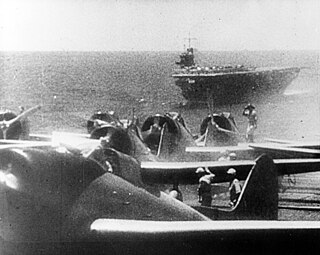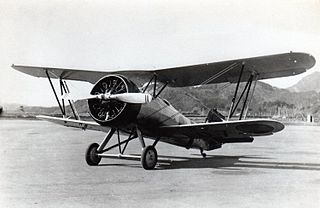Related Research Articles

The Aichi D3A Type 99 Carrier Bomber is a World War II carrier-borne dive bomber. It was the primary dive bomber of the Imperial Japanese Navy (IJN) and was involved in almost all IJN actions, including the attack on Pearl Harbor.

The Aichi B7A Ryusei was a large and powerful carrier-borne torpedo-dive bomber produced by Aichi Kokuki for the Imperial Japanese Navy Air Service during the Second World War. Built in only small numbers and deprived of the aircraft carriers it was intended to operate from, the type had little chance to distinguish itself in combat before the war ended in August 1945.

The Mitsubishi A5M, formal Japanese Navy designation Mitsubishi Navy Type 96 Carrier-based Fighter (九六式艦上戦闘機), experimental Navy designation Mitsubishi Navy Experimental 9-Shi Carrier Fighter, company designation Mitsubishi Ka-14, was a Japanese carrier-based fighter aircraft. It was the world's first low-wing monoplane shipboard fighter to enter service and the predecessor to the famous Mitsubishi A6M "Zero". The Allied reporting name was Claude.

The Yokosuka D4Y Suisei is a two-seat carrier-based dive bomber developed by the Yokosuka Naval Air Technical Arsenal and operated by the Imperial Japanese Navy from 1942 to 1945 during World War II. Development of the aircraft began in 1938. The first D4Y1 was complete in November 1940 and made its maiden flight at Yokosuka the following month.

The Nakajima B5N was the standard carrier-based torpedo bomber of the Imperial Japanese Navy (IJN) for much of World War II.

The Mitsubishi F1M was a Japanese reconnaissance floatplane of World War II. It was the last biplane type of the Imperial Japanese Navy, with 944 built between 1936 and 1944. The Navy designation was "Type Zero Observation Seaplane" (零式水上観測機).

The Nakajima A4N was a carrier-based fighter used by the Imperial Japanese Navy, and the last biplane designed by Nakajima. The first prototype was completed in 1934, but due to engine trouble the aircraft did not see service until 1936. Given the Nakajima internal designation Nakajima YM, the Japanese Navy designation was Navy Type 95 Carrier Fighter. A total of 221 were built.

The Aichi D1A or Navy Type 94/96 Carrier Bomber was a Japanese carrier-based dive bomber of the 1930s. A single-engine, two-seat biplane based on the Heinkel He 50, the D1A was produced by Aichi for the Imperial Japanese Navy, remaining in service as a trainer at the time of the attack on Pearl Harbor. The D1A was produced in two variants, the D1A1, and the D1A2.

The Yokosuka B4Y,, carrier torpedo bomber was used by the Imperial Japanese Navy Air Service from 1936 to 1943. The B4Y replaced the Mitsubishi B2M2 and was the last biplane bomber used operationally by the Imperial Japanese Navy. The Allied reporting name was "Jean".

The Nakajima E4N was a Japanese shipboard reconnaissance aircraft of the 1930s. It was a two-seat, single-engine, equal-span biplane seaplane used primarily by the Imperial Japanese Navy.

The Kugisho B3Y, or Navy Type 92 Carrier Attack Bomber, also popularly titled Yokosuka B3Y, was a Japanese carrier-based torpedo bomber of the 1930s. It was designed by the Naval Air Technical Arsenal at Yokosuka, and while unimpressive during testing, it was ordered into service by the Imperial Japanese Navy and used until replaced by more capable aircraft.
The Nakajima LB-2 was a long-range, land-based bomber developed in Japan for use by the Imperial Japanese Navy. When rejected for military service, the sole prototype was converted into an airliner and, known as the Akatsuki-go, was operated by Manchukuo National Airways.
The Nakajima C3N-1 was a prototype Japanese carrier-based reconnaissance aircraft of the 1930s. A single-engine monoplane with a fixed undercarriage, although only two examples were built, they were both used operationally, carrying out land-based reconnaissance missions during the Second Sino-Japanese War.
The Nakajima B3N was a prototype Japanese carrier-based torpedo-bomber aircraft of the 1930s. A single-engined biplane with a crew of three, it was unsuccessful, only two being built.
The Aichi AB-6, or Aichi Experimental 7-Shi Reconnaissance Seaplane, was a prototype Japanese reconnaissance floatplane. It was a single-engined, three-seat biplane intended for the Imperial Japanese Navy, but only one was built, the rival aircraft from Kawanishi, the E7K being preferred.
The Aichi F1A was a prototype Japanese floatplane of the 1930s. A single-engined biplane, the F1A was intended as a short-range observation aircraft suitable for operation off the Imperial Japanese navy's warships, but only two were built, the Mitsubishi F1M being selected instead.

The Aichi E8A was a prototype Japanese reconnaissance floatplane of the 1930s. It was a two-seat single engined biplane built for the Imperial Japanese Navy. Only two were built.
The Kawanishi K-11 was a 1920s Japanese single-seat carrier fighter designed and built by the Kawanishi Aircraft Company to meet an Imperial Japanese Navy requirement. The type did not enter service and only two prototypes were built.

The Mitsubishi 2MB2 or Experimental Washi-type Light Bomber was a prototype Japanese single-engined biplane light bomber of the 1920s. A single example was built for the Imperial Japanese Army, but no production followed.

The Mitsubishi 1MF10 or Mitsubishi Experimental 7-Shi Carrier Fighter (七試艦上戦闘機) was a prototype Japanese monoplane single-seat carrier-based fighter aircraft of the 1930s. Two were built for the Imperial Japanese Navy, but both were lost in crashes, with no production following.
References
- Francillon, R. F. (1970). Japanese Aircraft of the Pacific War. London: Putnam. ISBN 0-370-00033-1.
- Mikesh, Robert C.; Abe, Shorzoe (1990). Japanese Aircraft 1910–1941. London: Putnam Aeronautical Books. ISBN 0-85177-840-2.